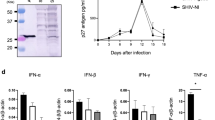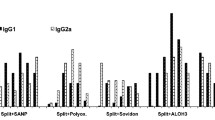Summary
This paper describes the minimal requirements to protect mice adoptively against challenge with virulent Semliki Forest virus (SFV). Early immune serum, from donor mice infected with an avirulent strain of SFV, contained mainly neutralizing IgM immunoglobulins. More of these antibodies (1.80 PND50 vs 0.06 PND50) were needed to protect recipient mice against intraperitoneal challenge (10 LD50 of SFV) than against subcutaneous challenge (7 LD50). Adoptive transfer experiments indicated that a minimum of 3×107 six-day immune spleen cells were also able to protect recipient mice against intraperitoneal challenge with 10 LD50 of SFV. Treatment of these donor cells with cytotoxic antisera and complement revealed both T- and B-lymphocytes were required for optimum adoptive immunity. Surviving recipients of either immune serum or immune spleen cells developed significantly less neutralizing antibodies than control mice. The lower antibody titres in protected mice might be related to either immune serum or immune spleen cell mediated restriction of virus replication; meaning a reduced antigenic stimulus in these mice compared to control mice.
Similar content being viewed by others
References
Atkins GJ, Sheahan BJ, Dimmock NJ (1985) Semliki Forest virus infection of mice: A model for genetic and molecular analysis of viral pathogenicity. J gen Virol 66: 395–408
Blackman MJ, Morris AG (1984) Gamma interferon production and cytotoxicity of spleen cells from mice infected with Semliki Forest virus. J gen Virol 65: 955–961
Boere WAM, Harmsen T, Vinjé J, Benaissa-Trouw BJ, Kraaijeveld CA, Snippe H (1985) Identification of distinct antigenic determinants on Semliki Forest virus by using monoclonal antibodies with different antiviral activities. J. Virol 52: 575–582
Bradish CJ, Allner K, Maber HG (1971) The virulence of original and derived strains of Semliki Forest virus for mice, guinea pigs and rabbits. J gen Virol 12: 141–160
Doherty PC (1973) Quantitative studies of the inflammatory process in fatal viral meningo encephalitis. American J Pathol 73: 607–621
Doherty PC, Palmer JC, Zinkernagel RM (1977) Experimental analysis of effector thymus-derived lymphocyte function in viral infections (chap 2). In:Maramorosch K, Koprowski H (eds) Methods in virology, vol VII. Academic Press, London, pp 29–59
Henderson BE, Metselaar D, Kirya GB, Timms GL (1970) Investigations into yellow fever virus and other arboviruses in the northern regions of Kenya. Bull WHO 42: 787–795
Kraaijeveld CA, Harmsen M, Khader Boutahar-Trouw BJ (1979) Delayed-type hypersensitivity against Semliki Forest virus in mice. Infect Immun 23: 219–223
Kraaijeveld CA, Harmsen M, Khader Boutahar-Trouw BJ (1979) Cellular immunity against Semliki Forest virus in mice. Infect Immun 23: 213–218
Kraaijeveld CA, Jansen J, Benaissa-Trouw B, Snippe H (1983) Delayed-type hypersensitivity in mice after infection with avirulent Semliki Forest virus. Arch Virol 78: 115–118
McFarland HE, Griffin DE, Johnson RT (1972) Specificity of the inflammatory response in viral encephalitis. I. Adoptive immunization of immunosuppressed mice infected with sindbis virus. J Exp Med 136: 216–226
Nowotny A (1979) Dissociation of macroglobulins with 2-mercaptoethanol. In:Nowotny A (ed) Basic exercises in immunochemistry. A laboratory manual, 2nd edn. Springer, Berlin-Heidelberg-New York, pp 12–14
Rabinowitz SG, Adler WH (1973) Host defences during primary venezuelan equine encephalomyelitis virus infection in mice. I. Passive transfer of protection with immune serum and immune cells. J. Immunol 110: 1345–1353
Rodda SJ, White DO (1976) Cytotoxic macrophages: a rapid nonspecific response to viral infection. J Immunol 117: 2067–2072
Snippe H, Van Eyk RVW (1974) Cells involved in thein vitro stimulation by DNP-carrier complexes ofin vivo primed mouse spleen cells. Immunology 27: 771–779
Snippe H, Willems PJ, Graven WG, Kamp E (1975) Delayed hypersensitivity in the mouse induced by hapten-carrier complexes. Immunology 28: 896–907
Author information
Authors and Affiliations
Rights and permissions
About this article
Cite this article
Kraaijeveld, C.A., Benaissa-Trouw, B.J., Harmsen, M. et al. Adoptive transfer of immunity against virulent Semliki Forest virus with immune spleen cells from mice infected with avirulent Semliki Forest virus. Archives of Virology 91, 83–92 (1986). https://doi.org/10.1007/BF01316730
Received:
Accepted:
Issue Date:
DOI: https://doi.org/10.1007/BF01316730




